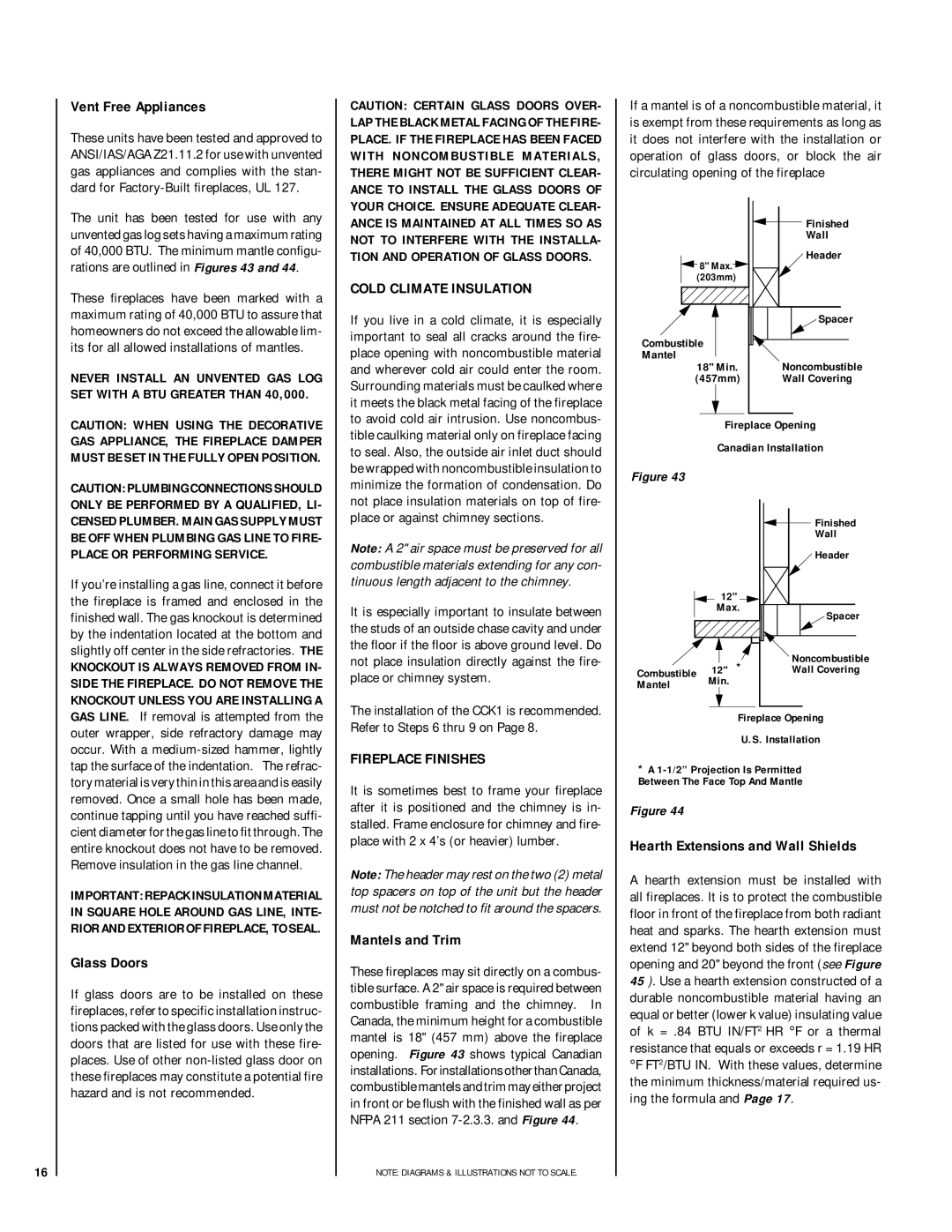
Vent Free Appliances
These units have been tested and approved to ANSI/IAS/AGA Z21.11.2 for use with unvented gas appliances and complies with the stan- dard for
CAUTION: CERTAIN GLASS DOORS OVER- LAP THE BLACK METAL FACING OF THE FIRE- PLACE. IF THE FIREPLACE HAS BEEN FACED WITH NONCOMBUSTIBLE MATERIALS, THERE MIGHT NOT BE SUFFICIENT CLEAR- ANCE TO INSTALL THE GLASS DOORS OF YOUR CHOICE. ENSURE ADEQUATE CLEAR-
If a mantel is of a noncombustible material, it is exempt from these requirements as long as it does not interfere with the installation or operation of glass doors, or block the air circulating opening of the fireplace
The unit has been tested for use with any unvented gas log sets having a maximum rating of 40,000 BTU. The minimum mantle configu- rations are outlined in Figures 43 and 44.
These fireplaces have been marked with a maximum rating of 40,000 BTU to assure that homeowners do not exceed the allowable lim- its for all allowed installations of mantles.
NEVER INSTALL AN UNVENTED GAS LOG SET WITH A BTU GREATER THAN 40,000.
ANCE IS MAINTAINED AT ALL TIMES SO AS NOT TO INTERFERE WITH THE INSTALLA- TION AND OPERATION OF GLASS DOORS.
COLD CLIMATE INSULATION
If you live in a cold climate, it is especially important to seal all cracks around the fire- place opening with noncombustible material and wherever cold air could enter the room. Surrounding materials must be caulked where it meets the black metal facing of the fireplace to avoid cold air intrusion. Use noncombus-
8" Max. |
(203mm) |
Combustible |
Mantel |
18" Min. |
(457mm) |
Finished
Wall
Header
Spacer
Noncombustible Wall Covering
CAUTION: WHEN USING THE DECORATIVE GAS APPLIANCE, THE FIREPLACE DAMPER MUST BE SET IN THE FULLY OPEN POSITION.
tible caulking material only on fireplace facing to seal. Also, the outside air inlet duct should be wrapped with noncombustible insulation to
Fireplace Opening
Canadian Installation
CAUTION: PLUMBING CONNECTIONS SHOULD ONLY BE PERFORMED BY A QUALIFIED, LI- CENSED PLUMBER. MAIN GAS SUPPLY MUST BE OFF WHEN PLUMBING GAS LINE TO FIRE- PLACE OR PERFORMING SERVICE.
If you’re installing a gas line, connect it before the fireplace is framed and enclosed in the finished wall. The gas knockout is determined by the indentation located at the bottom and slightly off center in the side refractories. THE
KNOCKOUT IS ALWAYS REMOVED FROM IN- SIDE THE FIREPLACE. DO NOT REMOVE THE KNOCKOUT UNLESS YOU ARE INSTALLING A
minimize the formation of condensation. Do not place insulation materials on top of fire- place or against chimney sections.
Note: A 2" air space must be preserved for all combustible materials extending for any con- tinuous length adjacent to the chimney.
It is especially important to insulate between the studs of an outside chase cavity and under the floor if the floor is above ground level. Do not place insulation directly against the fire- place or chimney system.
The installation of the CCK1 is recommended.
Figure 43
12" ![]() Max.
Max.
Combustible | 12" | * |
Mantel | Min. |
|
Finished
Wall
Header
Spacer
Noncombustible Wall Covering
16
GAS LINE. If removal is attempted from the outer wrapper, side refractory damage may occur. With a
IMPORTANT: REPACK INSULATION MATERIAL IN SQUARE HOLE AROUND GAS LINE, INTE- RIOR AND EXTERIOR OF FIREPLACE, TO SEAL.
Glass Doors
If glass doors are to be installed on these fireplaces, refer to specific installation instruc- tions packed with the glass doors. Use only the doors that are listed for use with these fire- places. Use of other
Refer to Steps 6 thru 9 on Page 8.
FIREPLACE FINISHES
It is sometimes best to frame your fireplace after it is positioned and the chimney is in- stalled. Frame enclosure for chimney and fire- place with 2 x 4’s (or heavier) lumber.
Note: The header may rest on the two (2) metal top spacers on top of the unit but the header must not be notched to fit around the spacers.
Mantels and Trim
These fireplaces may sit directly on a combus- tible surface. A 2" air space is required between combustible framing and the chimney. In Canada, the minimum height for a combustible mantel is 18" (457 mm) above the fireplace opening. Figure 43 shows typical Canadian installations. For installations other than Canada, combustible mantels and trim may either project in front or be flush with the finished wall as per NFPA 211 section
NOTE: DIAGRAMS & ILLUSTRATIONS NOT TO SCALE.
Fireplace Opening
U.S. Installation
*A
Figure 44
Hearth Extensions and Wall Shields
A hearth extension must be installed with all fireplaces. It is to protect the combustible floor in front of the fireplace from both radiant heat and sparks. The hearth extension must extend 12" beyond both sides of the fireplace opening and 20" beyond the front (see Figure 45 ). Use a hearth extension constructed of a durable noncombustible material having an equal or better (lower k value) insulating value of k = .84 BTU IN/FT2 HR ° F or a thermal resistance that equals or exceeds r = 1.19 HR
°F FT2/BTU IN. With these values, determine the minimum thickness/material required us- ing the formula and Page 17.
